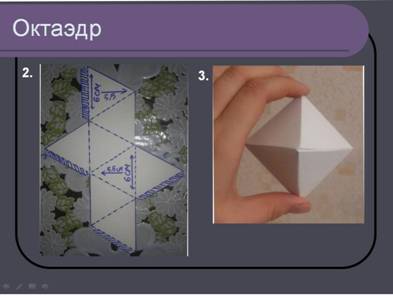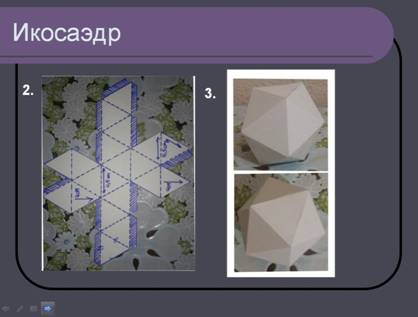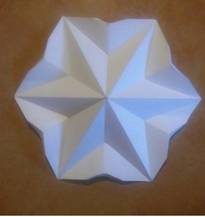SPECIFIC AND METHODICAL SUPPORT OF THE LESSON (SESSION) ON PAPER PLASTIC.
Subject: "Volumetric geometric shapes."
Goals and objectives of the lesson: To develop a student’s imaginative three-dimensional thinking and imagination. The assignment involves familiarization with the material, the acquisition of the ability to perform accurate drawings, cut out various shapes, the ability to use sharp cutting objects (cutter, scissors), glue together parts and assemble a three-dimensional geometric figure.
Equipment: At the teacher: computer and projector, product samples, tools (scissors, cutter, paper, ruler, pencil, eraser, glue), templates, safety instructions for working with cutting tools, presentation. Students: underlay wooden board (30 * 20 cm), scissors, cutter, paper (Whatman) A3 format - 2 sheets, ruler, pencil (hard), eraser, glue (moment “crystal”).
Lesson Type: mixed
During the classes:
1. Organizational moment -1 minute.
Check readiness for the lesson.
2. Teacher's explanation - 9 minutes.
Post lesson topics, goals and objectives.
Material explanation:
In the process of classes, the teacher sequentially talks and clearly shows about the construction of drawings for three-dimensional geometric figures and purposefully forms the students' ability to work with hands, accustoms to precise finger movements, improves fine motor skills of hands, develops an eye.
- « From a sheet of paper using a cutter, scissors and glue, you can quickly perform a model of a product, a simple composition, layout. Unlike clay sculptures, where the mass is gained by the method of building and form refinement, there is no skeleton in paper products. Almost all products are hollow and are like shells. However, this is not a print from the finished form, but a completely independent plastic shell created by folding the paper along previously drawn lines - notches. The notches are the structural basis of all products made of paper (they are called stiffeners). A sheet bent in half forms an edge. If the sheet is folded several times, then from the number and nature of these straight folds you can get a different texture».
The basic qualities of the abilities formed by classes, on the one hand, relate mainly to the field of perception (the development of an analytical-synthetic view of the subject), and on the other hand, to the field of motility (optional area of \u200b\u200bthe hand). The main form of conducting classes is a lesson of a mixed type (a lecture is combined with practical work).
3. Practical work of students - 1 hour 20 minutes.
For work, mockups of geometric shapes of various sizes and shapes were selected.
Progress:
1. On a sheet of white paper (whatman), we outline the sizes and contours to create geometric shapes as indicated on the template.
2. Cut along the contour, make cuts on the inner edges of the figure from the front side. We remove the auxiliary lines with the eraser and bend.
3. Lubricate the areas marked with the inscription "for glue" (as indicated on the template) with glue and proceed to the construction.
By the same principle, a task is performed with the following geometric figures.
5 minutes before the end of the lesson, mini-viewing and discussion of works.
Visual material for the lesson.
Presentation for the lesson.: Paper plastics. Volumetric geometric shapes.


The geometric pyramid.
http://pandia.ru/text/80/128/images/image005_30.jpg "width \u003d" 447 height \u003d 339 "height \u003d" 339 "\u003e
Explanation of the slide: 2. After applying the drawing, cut along the contour (solid line) and make cuts with a cutter along the line indicated by the dotted line. The auxiliary lines are deleted with an eraser
Octahedron.
DIV_ADBLOCK219 "\u003e
.
3. Additional inserts in the figure marked with hatching are greased with glue and glue the figure with additional inserts inside.
dodecahedron.
http://pandia.ru/text/80/128/images/image009_14.jpg "width \u003d" 441 height \u003d 340 "height \u003d" 340 "\u003e.
Explanation of the slide: 2. After applying the drawing, cut along the contour (solid line) and make cuts with a cutter along the line indicated by the dotted line. The auxiliary lines are deleted with an eraser.
3. Additional inserts in the figure marked with hatching are greased with glue and glue the figure with additional inserts inside.
ICOSAEDR.

Explanation of the slide: 1. The drawing of the icosahedron is transferred to the student’s sheet with an accuracy of 1: 1, as indicated on the template. The construction begins with an isosceles triangle, one side of which is 4.5 cm and height is 4 cm. Next, as indicated on the template, we transfer the drawing of all the remaining isosceles triangles.

Explanation of the slide: 2. After applying the drawing, cut along the contour (solid line) and make cuts with a cutter along the line indicated by the dotted line. The auxiliary lines are deleted with an eraser.
3. Additional inserts in the figure marked with hatching are greased with glue and glue the figure with additional inserts inside.
pedagogical drawing of a teacher.
examples of student work.

Volumetric geometric shapes of the senior group 2/4 class.
Teacher:.
Exercise "Star"
Lesson objectives | Methods and techniques |
|
· To give an idea of \u200b\u200bthe history of paper plastic. · Introduce the basic methods of working with paper using the technology of paper plastic · To acquaint with the main stages of the work, to teach accuracy during the work · To develop a student’s imaginative three-dimensional thinking and imagination. · To reinforce students' understanding of paper plastic. |
Use of visibility Do it yourself Comparison |
|
Equipment | Materials | |
Multimedia Visual material | Drawing paper, stationery cutter, scissors, ruler, compass, pencil, eraser | Performing the exercise "Star" in the technique of paper plastic. |
Lesson plan | Work sample |
|
1.Organization 3 min. 2. Introductory conversation 10 min. 3. Independent work 30 min. 4. The conclusion of 2 minutes. |
|
1. The organizational part.
Our task for today's lesson will be an exercise in the paper star technique.
2. Explanation of the material.
Paper plastics. What is it: paper sculpture, architecture or design? This type of artistic activity is equally fashionable to attribute to all these areas, since paper, as a project material, is widely used by artists, architects, and designers. From a sheet of paper using a cutter, scissors and glue, you can quickly perform a model of a product, a simple composition, layout.
Paper plastic is close to sculpture. Unlike clay sculptures, where the mass is gained by the method of building and refinement of forms, there is no skeleton in paper products. Almost all products are hollow and are like shells. However, this is not a print from the finished form, but a completely independent plastic shell created by folding the paper along previously drawn lines - notches.
Features of technology. The notches are the structural basis of all products made of paper (hereinafter they will be called - stiffeners). A sheet bent in half forms an edge. If the sheet is folded several times, then from the quantity and nature of these straight folds you can get a different texture. In Japan, this method in paperwork is called - origami.
Materials and tools. The main tool in paper plastic is a cutter (stationery knife). Scissors are needed for cutting paper, making various patterns, cuts, cuts, etc. A ruler, preferably a metal length of 25-30 cm, because plastic and wooden rulers are not accurate, and quickly fail. Compass, to build a circle and divide it into six parts.
3. Performance of work.
Today we got acquainted with the technique of paper plastic, watched a multimedia presentation in this area, and on a visual aid we looked and touched what this technique is like. And now we’ll try to complete the “star” exercise. To do this, tools such as a ruler, pencil, eraser, cutter, and scissors should be at your workplace. The exercise will be done from paper. Each of you also has a template on the tables to do the work with the given sizes. Please note: the yellow line is the construction, we cut out along the brown line, the straight green lines are cut with the cutter and bend away from us, the green dotted lines are cut with the cutter and bent towards ourselves. We begin the work with a drawn circle with a diameter of 20 cm. Then we proceed to the drawing of auxiliary lines and proceed to design.
4. Securing the material covered.
So our creative lesson came to an end. We met with you a new direction in art - the technique of paper plastic. So tell me please, what is the difference between paper sculpture and clay sculpture? In which country is this technique used abroad, and what is its name there? What materials may we need when creating a paper composition?
Large selection of unfolding simple geometric shapes.
The first acquaintance of children with paper modeling always begins with simple geometric shapes, such as a cube and a pyramid. Not many people manage to glue the cube the first time, sometimes it takes several days to make a truly smooth and flawless cube. More complex figures, a cylinder and a cone require several times more effort than a simple cube. If you don’t know how to accurately glue geometric shapes, then it’s too early for you to tackle complex models. Take care of yourselves and teach your children how to crate these “basics” of modeling in ready-made patterns.
To begin with, I, of course, suggest learning how to glue a regular cube. Reamers are made for two cubes, large and small. A more complex figure is a small cube because it is more difficult to glue it than a large one.
So, let's begin! Download the unfolding of all the figures on five sheets and print it on thick paper. Before you print and glue geometric shapes, be sure to check out the article on how to choose paper and how to cut, bend and glue paper in general.
For better printing, I advise you to use the AutoCAD program, and I give you a scan for this program, and also read how to print from AutoCAD. Cut the development of the cubes from the first sheet, along the fold lines, be sure to draw a compass needle under the iron ruler so that the paper bends well. Now you can start gluing the cubes.
To save paper and for every fireman, I made several scans of a small cube, do you really want to glue more than one cube or something will not work the first time. Another simple figure is a pyramid, you can find its development on the second sheet. Ancient Egyptians cost similar pyramids, though not from paper and not so small :)
And this is also a pyramid, but unlike the previous one, it has not four, but three faces.
The development of the trihedral pyramid on the first sheet for printing.
And another funny pyramid of five faces, its development on the 4th sheet in the form of an asterisk in duplicate.
A more complex figure is a pentahedron, although a pentahedron is more difficult to draw than to glue.
The development of the pentagon on the second sheet.
So we got to the complex figures. Now you have to work hard, gluing such figures is not easy! To begin with, an ordinary cylinder, its development on the second sheet.
And this is a more complex figure compared to the cylinder, because at its base is not a circle, but an oval.
The unfolding of this figure on the second sheet, for the oval base made two spare parts.
To carefully assemble the cylinder, its parts must be glued butt. On the one hand, the bottom can be glued without problems, just put a pre-glued tube on the table, put a circle on the bottom and fill it with glue from the inside. Make sure that the diameter of the pipe and the round bottom fit tightly together, without gaps, otherwise the glue will leak and everything will stick to the table. Gluing the second circle will be more difficult, so glue inside the auxiliary rectangles at a distance of the thickness of the paper from the edge of the pipe. These rectangles will not let the base fall inside, now you can easily glue the circle on top.
A cylinder with an oval base can be glued as well as a regular cylinder, but it has a lower height, so it’s easier to insert a paper accordion inside, put a second base on top and glue it around the edge.
Now a very complex figure is a cone. Its details are on the third sheet, a spare circle for the bottom on the 4th sheet. The whole difficulty of gluing a cone in its sharp peak, and then it will still be very difficult to glue the bottom.
A complex and at the same time simple figure is a ball. The ball consists of 12 pentahedrons, the development of the ball on the 4th sheet. First, two halves of the ball are glued, and then both are glued together.
A rather interesting figure is a rhombus, its details on the third sheet.
And now there are two very similar, but completely different figures, their difference only at the base.
When you glue these two shapes together, you don’t immediately understand what it is, they turned out to be completely immune.
Another interesting figure is a torus, only it is very simplified here, its details are on the 5th sheet.
And finally, the last figure from equilateral triangles, I don’t even know what to call it, but the figure looks like a star. Scans of this figure on the fifth sheet.
That's all for today! I wish you success in this difficult job!
Croup through a sieve - each child should have its own sieve. Transfusions and games with water Development motor skills, preparing hands for writing. Development Motility is very important for children ... ... following a harmonious sequence. Simple math: a box named Ten Creation. Joint activities creativity for children of different ages to organize not ... ... cotton wool - such an activity will entertain him for a long time. The oldest child can do at this time. applique: Glue pieces of colored paper onto the blank. - Sculpt from plasticine ...
Update date: 07/01/2017
I would go to artists ... Why should children draw
Which then need to be painted, multi-colored sand for paintings. In recent years, such species are gaining popularity in Russia. creativitylike quilling (volumetric appliques from folded narrow strips of colorful paper), origami (national Japanese creationfolding paper toys), scrapbooking (design of photo albums, notebooks and postcards of various kinds appliques) Of course, it is not easy for children to deal with some of them. For example, for quilling is very important excellent developed fine motor skills, and it can be difficult for a baby to hold narrow paper strips in their hands and properly glue these coiled snails, which strive to unfold at the most inopportune moment ... But do not rush to lose heart: in some forms creativity ...
Date updated: 10/20/2016
The largest list of games for activities with the baby
To portray other animals (walk like a bear, jump and croak like a frog, etc.). DEVELOPMENT Logic 1. “Collect only” (learn to choose from the scattered objects only ... ... (ant bee, etc.). 20. Sun, clouds, month, moon, stars, rain, snow, puddles. Creation 1. Drawing: wax crayons, paints, felt-tip pens (it is better to take it on the water ... ... the child will easily learn at 1.5 years old, something will “come” after two - everyone has different ways. 9. Applique from paper (various invoices), applique from torn paper applique of...
Update date: 06/20/2016
Creativity with two children: together - more fun!
An opportunity to develop both children at once. With this activity, you can develop fine motor skills, a sense of color, development fantasies and many other aspects of parenting. Also, this activity has the ability to enthrall absolutely everyone ... ... potato stamps. Awaken the imagination of children, infect them with a new idea - and enjoy the peace and happiness that is saturated creation with kids! Voluminous appliques with an unconventional approach No child refuses to do applique in the company of your brother or sister. Can...
Update date: 06/11/2016
If you're tired of just drawing ...
The process is a lot of fun. And they need to create all the conditions. Along with planar applique teach them how to do volumetric: volumetric is better perceived by a preschooler and ... ... cut out from postcards, portray the sky and clouds with tissues, etc. Limit to improvement and creativity in visual activity no. We draw on pebbles The very shape of a pebble ... ... to them. Drawing only benefits your baby. Drawing fruitfully affects development memory and attention development fine motor skills and imagination. Imagination and fantasy ...



